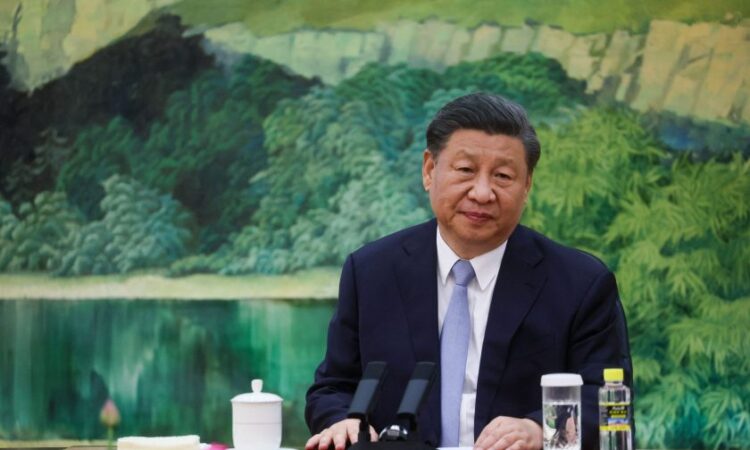

Chinese President Xi Jinping attends a meeting with U.S. Secretary of State Antony Blinken (not pictured) at the Great Hall of the People in Beijing on June 19, 2023. Leah Millis—POOL/AFP/Getty Images
In their push to dethrone the U.S. dollar as the world’s largest reserve currency, the BRICS nations—or Brazil, Russia, India, China, and South Africa—have been talking up the idea of a common currency for years. But Jim O’Neill, the veteran economist who coined the term BRIC (the group did not originally include South Africa) when he worked at Goldman Sachs in 2001, blasted the plan this week.
“It’s just ridiculous,” he told the Financial Times Tuesday. “They’re going to create a BRICS central bank? How would you do that? It’s embarrassing almost.”
The BRICS nations will meet for their 15th annual summit next week, but O’Neill, now senior advisor at U.K.-based think tank Chatham House, argued that the group of nations has “never achieved anything since they first started meeting” in 2009 amid consistent infighting.
The push for de-dollarization among BRICS nations has heated up since the war in Ukraine began, as crippling Western sanctions on Russia were enabled by the dollar’s dominance. In April, Brazilian President Luiz Inácio Lula da Silva urged the group to develop a serious alternative to the dollar using the combined weight of their economies.
“Why can’t we do trade based on our own currencies?” he said on a state trip to China in April, the Financial Times first reported. “Who was it that decided that the dollar was the currency after the disappearance of the gold standard?”
Despite the ongoing talk of de-dollarization, nearly 60% of global currency reserves were held in U.S. dollars in 2022, and 88% of international transactions used the dollar, according to IMF data. And Wall Street doesn’t seem to be worried about a serious competitor to the greenback either.
Dylan Kremer, co–chief investment officer at Certuity, which manages nearly $4 billion in assets, said that the development of a common BRICS currency is just a “talk track,” referencing the talking points salespeople bring to client meetings. BRICS nations, when combined, lack the political stability to make investors confident in a combined currency, he argued.
“There is not an immediate threat to the dollar over the next 10 years,” Kremer told Fortune. “Any threat to the dollar or competitor to the dollar would be a slower-moving kind of snowball effect.”
For O’Neill, the unhealthy relationship between China and India is one of the main reasons a BRICS common currency is so unlikely.
“It’s a good job for the West that China and India never agree on anything, because if they did the dominance of the dollar would be a lot more vulnerable,” he told the Financial Times. “I often say to Chinese policymakers…forget your endless historical battles and try to invite India to share the leadership on some big issues, because then the world might take you a bit more seriously.”
China and India’s fractured relationship is to the dollar’s advantage
The rivalry between China and India is so huge and so old that it goes beyond economics in many ways. Harvard Business School’s Tarun Khanna wrote in the Harvard Business Review in 2007 that there was “mutual respect and admiration” for literally thousands of years, as the “Tea and Horse Road” powered the development of two great civilizations. The Sino-Indian War of 1962 changed all that, and mistrust has reigned since. In recent years, the world’s largest nations by population have clashed in violent skirmishes along their 2,360-mile border, leading India to ban dozens of Chinese apps and sanction Chinese investment firms in retaliatory measures.
Like the U.S., India has also sought to reduce its reliance on Chinese imports after the COVID-induced supply-chain nightmares of the past few years. The country entered the Resilient Supply Chain Initiative with Japan and Australia in 2021 as well as free trade negotiations with the European Union last year. In a rebuke of this shift in India’s supply chains, Chinese President Xi Jinping said at a virtual summit of the Shanghai Cooperation Organization in July that he opposes “decoupling and breaking links,” according to a CNBC translation.
The tensions over trade deals and the border have carried over to BRICS meetings as well, with India pushing back against China’s move to expand the group’s membership this summer.
In a June 1 interview with Desné Masie, chief economist at IC Intelligence, O’Neill said creating a common currency that includes China and India would be “very challenging” to say the least, referencing the rival nations’ ongoing border disputes.
“China and India can’t even really agree on basic things like a peaceful border. I mean, how on earth can people seriously believe these guys are going to introduce a shared currency?” he said. “It’s amusing. Sorry. I just think it’s fanciful.”
In the short term, then, it seems O’Neill’s prediction is accurate that a BRICS currency would be “ridiculous.” But thousands of years of history could tell another story in the long run.
